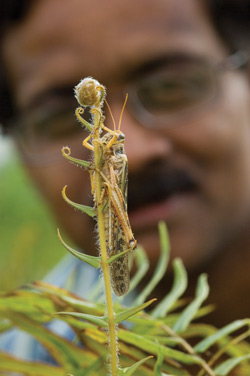|
|
Ferns May Absorb Arsenic To Repel Bugsdownloadable pdf
In the struggle for survival, plants are often at the mercy of hungry animals — but one fern has turned the tables by using poisonous arsenic to reduce its appeal, say University of Florida researchers. A study published in April in the journal New Phytologist showed starving grasshoppers shunned Chinese brake fern — one of several fern species known to store arsenic — when the plants contained large quantities of the toxic heavy metal. It is the first published study showing that arsenic accumulated in plant tissue deters predators. The grasshoppers somehow sensed the ferns contained arsenic, which is poisonous to insects, said study co-author Bala Rathinasabapathi, an associate professor in UF’s horticultural sciences department. “So there is the potential for going further into (this research) to find out how the insect senses it and to develop deterrents — chemicals that have the same effect as arsenic but are less toxic,” said Rathinasabapathi. He conducted the laboratory work for the study with entomology graduate student Murugesan Rangasamy. Researchers believe arsenic may cause brake fern to produce other toxic compounds that ward off insects — another avenue for research that might lead to new insecticides or insect deterrents. Arsenic is used in pest and weed control, to preserve wood and to make fireworks, metal and electronics. Toxic to humans, it contaminates soil at thousands of sites worldwide. UF researchers discovered the fern’s remarkable capacity to absorb arsenic, publishing their findings in the journal Nature in 2001. It was the first plant known to accumulate large quantities of arsenic, although many plants store other metals. Eventually, the brake fern may be useful in phytoremediation, the practice of growing plants to remove toxic materials from soil, said Lena Ma, a UF professor with the soil and water science department and lead researcher in the 2001 study. Rathinasabapathi and Ma are trying to identify genes that allow brake fern to absorb arsenic. Once the genes are pinpointed, it may be possible to transfer them to plants better suited to phytoremediation, Ma said. In the recent study, American grasshoppers readily ate brake ferns that contained traces of arsenic, about three milligrams per kilogram of plant mass. But the insects hardly touched fortified ferns with 15 times as much arsenic. Researchers starved the grasshoppers before turning them loose on the ferns, then determined how much they ate by examining the plants, weighing the insects and evaluating how much waste they produced. “The grasshoppers will try the leaves (of the arsenic-laden ferns) if they have nothing else to eat, but eat no more than their initial test bites,” Rathinasabapathi said. A second experiment showed grasshoppers shied away from lettuce leaves soaked in an arsenic solution but eagerly devoured lettuce dipped in water. This suggests the insects were repelled by arsenic itself, rather than some reaction the metal causes in the fern, he said. UF’s School of Natural Resources and Environment funded the study. Bala Rathinasabapathi, brath@ufl.edu Tom Nordlie |

